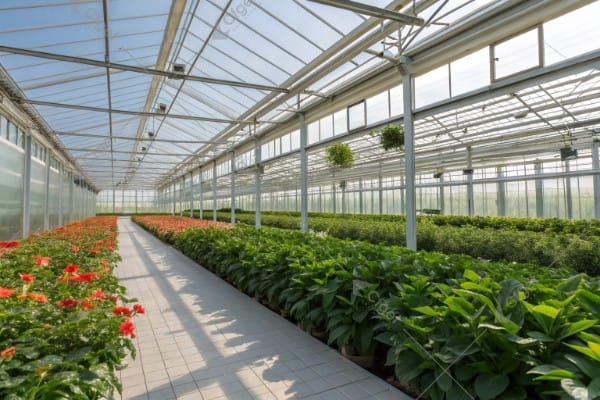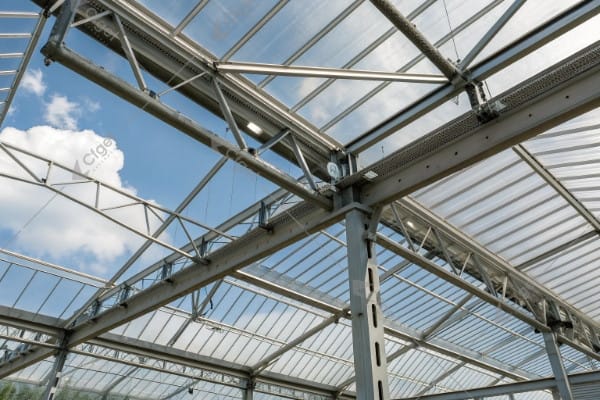Struggling to make commercial hydroponics profitable? Poor design and construction choices can drain your resources before you even harvest. We help you connect the dots for success.
Success in commercial hydroponics hinges on aligning system design, greenhouse construction, and return on investment (ROI) analysis from the start. Careful planning ensures efficiency, optimizes yields, and maximizes profitability by considering environmental control, crop choice, and operational costs.
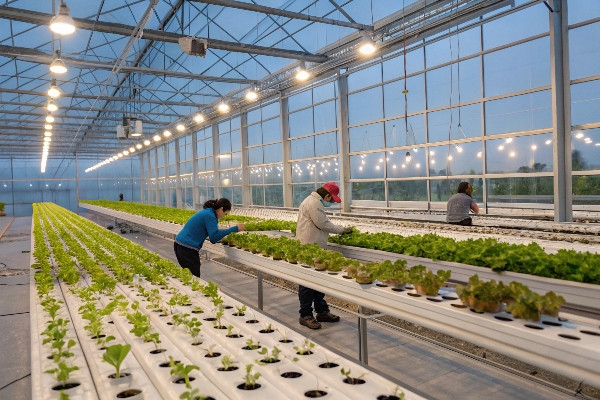
Choosing to invest in a commercial hydroponic greenhouse system is a significant step. It’s more than just setting up some grow beds; it’s about creating a highly controlled environment tailored for optimal plant growth without soil. We see many growers excited about the potential yields, but success truly comes from understanding how every element works together. The design of your hydroponic setup, the structure of your greenhouse, and your financial projections are deeply linked. Get one part wrong, and it can negatively impact the others, affecting your overall return. Let’s explore these connections.
How Can Businesses Build a Profitable Hydroponic Greenhouse?
Worried that your hydroponic greenhouse venture won’t turn a profit? Many factors influence success, making it seem complex. We simplify the path to profitability for you.
Building a profitable hydroponic greenhouse requires selecting appropriate crops, optimizing the growing environment with the right greenhouse structure and systems, managing operational costs efficiently, and ensuring effective market access for your produce.
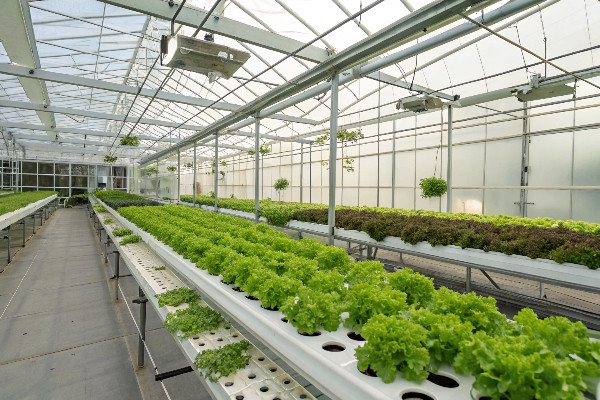
Profitability is the core goal for any commercial agricultural venture, and hydroponic greenhouses are no exception. Based on our 28 years at CFGET, helping clients worldwide, we’ve seen that success isn’t accidental. It starts with smart planning. You need to consider what crops you’ll grow. Many of our clients focus on leafy greens like lettuce, spinach, or herbs because they have fast growth cycles, often around 30-35 days. This rapid turnover is key to generating consistent revenue. Others might explore high-value crops like tomatoes, peppers, or strawberries, which require different system designs and potentially longer cycles but offer higher market prices.
Beyond crop selection, the greenhouse itself is crucial. It acts as the primary barrier against external environmental fluctuations. For instance, clients in Southeast Asia need designs focusing on excellent ventilation and cooling to combat high heat and humidity. In contrast, those in Central Asia might prioritize structures that withstand extreme temperatures and wind, requiring robust materials and insulation. European clients often emphasize energy efficiency and sustainability, influencing choices in glazing materials and heating/cooling systems. The structure must support the chosen hydroponic system and environmental controls effectively. Integrating efficient lighting (like LEDs for supplementary light), precise nutrient delivery systems, and climate control (heating, cooling, ventilation, humidity management) is essential. These systems directly impact yield, quality, and operational costs, all driving profitability. Finally, operational efficiency – managing labor, energy, water, and nutrient costs – and having a solid plan to sell your produce are vital pieces of the profitability puzzle. We work closely with growers to tailor designs that balance upfront investment with long-term operational savings and market demands.
| Factor | Key Considerations for Profitability | CFGET Approach |
|---|---|---|
| Crop Choice | Market demand, price points, growth cycle, suitability for hydroponics | Guidance on high-yield, fast-turnover crops (e.g., leafy greens) or high-value options. |
| Greenhouse | Climate suitability, structural integrity, environmental control integration | Custom designs for regional climates (SE Asia, Europe, Central Asia), robust materials. |
| Systems | Efficiency (water, energy, nutrients), scalability, maintenance | Integration of precise NFT, DWC, or other systems; advanced climate control. |
| Operations | Labor efficiency, resource management (water, energy), nutrient costs | Designs facilitating workflow; recommending automation; advice on nutrient management. |
| Market | Access to buyers, consistent demand, pricing strategy | Consultation on market trends and aligning production with demand. |
Don’t miss out:——Hydroponic Greenhouses: Higher Yields, Faster Growth, and Less Water Use – Is It True?
Don’t miss out:——Sustainable Agriculture: Is the Role of Smart Greenhouses Key to a Greener Future?
Which Hydroponic System is Right for Your Greenhouse: NFT, DWC, or Others?
Feeling overwhelmed by the variety of hydroponic systems available? Choosing the wrong one can lead to poor yields and wasted resources. Let us guide you to the perfect fit.
The best hydroponic system (like NFT, DWC, Dutch Bucket, or Aeroponics) depends on your target crops, budget, space, scale of operation, and desired level of automation. Each has unique pros and cons.
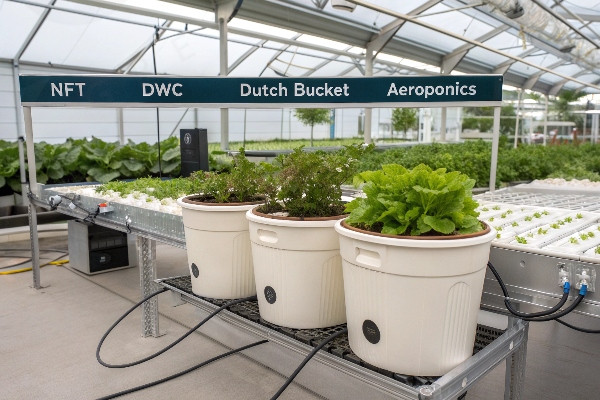
Selecting the right hydroponic system is a critical decision in your greenhouse setup. At CFGET, we often guide clients through this choice, considering their specific goals. The most common systems we encounter are Nutrient Film Technique (NFT) and Deep Water Culture (DWC), but others like Dutch Buckets, Aeroponics, and even aquaponics (fish and vegetable symbiosis, as some of our clients use) have their place.
NFT systems involve flowing a thin film of nutrient solution over the bare roots of plants in channels or gullies. It’s very popular for leafy greens like lettuce and herbs because it’s water-efficient and allows for easy harvesting. However, it’s sensitive to pump failures and flow interruptions. DWC, on the other hand, suspends plant roots directly in a nutrient-rich, oxygenated water solution. It’s great for water-loving plants and can be simpler mechanically, but managing water temperature and oxygen levels is crucial.
For vining crops like tomatoes, cucumbers, or peppers, Dutch Bucket systems (using an inert medium like perlite or coco coir with drip irrigation) are often preferred. They provide more root support. Aeroponics, which mists roots with nutrient solution, offers maximum oxygen exposure and potentially faster growth but requires precise control and is sensitive to nozzle clogging. We also see interest in vertical systems – towers, multi-layer setups – especially where space is limited, maximizing output per square meter.
The choice also depends on your location and resources. A grower in Central Asia might prioritize robustness and ease of maintenance, perhaps leaning towards DWC or Dutch Buckets. A high-tech operation in Europe might favor the precision of NFT or aeroponics integrated with sophisticated control systems. Our experience shows that the biggest challenge, especially for beginners, regardless of the system, is mastering the nutrient solution – getting the mix of water and fertilizers just right for optimal plant growth. This often requires some trial and error, or expert guidance, which we are happy to provide based on our extensive project history.
| System Type | Best Suited Crops | Pros | Cons | Considerations |
|---|---|---|---|---|
| NFT | Leafy greens, herbs, strawberries | Water efficient, easy harvest, suitable for vertical setups | Sensitive to pump failure, potential root matting, requires slope | Pump reliability, channel cleaning |
| DWC | Leafy greens, larger root crops | Simple mechanics, less prone to clogging, good root oxygenation | Requires water temp control, large water volume, potential diseases | Oxygenation method (air stones), water chilling |
| Dutch Bucket | Vining crops (tomatoes, cucumbers) | Good root support, uses various media, scalable | Requires growing media, potential salt buildup | Media choice, flushing schedule |
| Aeroponics | Leafy greens, herbs, root crops (exp) | Fastest growth potential, maximum oxygen, water efficient | High initial cost, complex, sensitive to nozzle clogs & power loss | Misting cycle precision, pump/nozzle quality |
| Vertical/Tower | Leafy greens, herbs, strawberries | Maximizes space, high density planting | Can have uneven light/airflow distribution, higher initial cost | Lighting design, accessibility for maintenance |
| Aquaponics | Leafy greens, herbs, some fruits | Sustainable (fish waste fertilizes plants), organic potential | Complex balancing act (fish, bacteria, plants), slower start-up | Fish health management, water quality testing |
What Does a Hydroponic Greenhouse Cost Analysis Entail: Investment, Expenses, and Profitability?
Unsure about the true cost of setting up and running a hydroponic greenhouse? Hidden expenses can derail your budget and impact profitability. We help you analyze costs accurately.
A thorough cost analysis includes initial investment (greenhouse structure, hydroponic system, environmental controls), ongoing operating expenses (utilities, nutrients, labor, seeds, maintenance), and projected revenue to determine profitability and ROI.
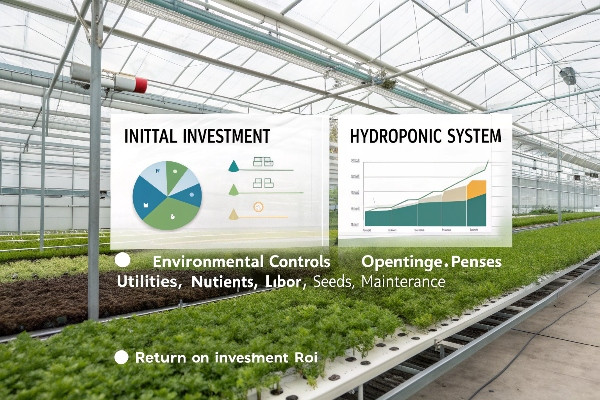
Understanding the financials is absolutely essential before launching a commercial hydroponic greenhouse. We always stress this with our clients. It’s easy to focus on the potential high yields, but a clear-eyed view of the costs is needed for sustainable success. The analysis breaks down into two main parts: initial investment (CapEx) and ongoing operating expenses (OpEx).
Initial investments cover the big-ticket items. This starts with the greenhouse structure itself – the foundation, frame, glazing (poly film, polycarbonate, or glass), doors, and vents. The cost here varies significantly based on size, materials, and climate requirements (e.g., stronger structures for high winds in Central Asia, specific ventilation for humidity in Southeast Asia). Then comes the hydroponic system – NFT channels, DWC tanks, pumps, reservoirs, piping, grow media (if any). Environmental controls are another major component: heating systems, cooling systems (fans, pads, foggers), ventilation systems, supplemental lighting (LEDs are common now), CO2 enrichment systems, and the control computer or sensors that automate everything. Installation labor is also a significant upfront cost.
Operating expenses are the recurring costs needed to keep the system running. Utilities are often the largest chunk, primarily electricity for pumps, lights, fans, and heating/cooling. Water costs can add up, though hydroponics is generally more water-efficient than traditional farming. Nutrients and pH adjusters are a constant expense, directly tied to the crops being grown and the system’s efficiency. Labor costs for planting, monitoring, harvesting, packing, and maintenance are critical. Other OpEx includes seeds or seedlings, pest and disease management supplies, packaging materials, insurance, and potentially marketing or distribution costs.
Profitability emerges when your revenue from crop sales consistently exceeds your operating expenses, eventually covering the initial investment. Calculating the Return on Investment (ROI)1 involves comparing the net profit over time to the initial investment. A realistic ROI projection considers yield estimates, market prices for your produce, and accurate cost figures. We help clients develop these projections, factoring in variables like crop cycles (e.g., 30-35 days for lettuce means potentially 10-12 harvests per year) and system efficiency to build a solid business case.
| Cost Category | Examples | Factors Influencing Cost | Notes |
|---|---|---|---|
| Initial Investment (CapEx) | Greenhouse structure, Hydroponic system (NFT, DWC, etc.), Environmental controls (HVAC, lights, sensors), Installation | Size, materials, technology level, climate, automation level | Can vary widely; requires detailed quotes. |
| Land preparation, Backup generator | Site conditions, reliability needs | Often overlooked but crucial. | |
| Operating Expenses (OpEx) | Electricity (pumps, lights, HVAC), Water, Nutrients & pH adjusters | Utility rates, system efficiency, crop needs, climate | Energy is often the largest OpEx; efficiency matters. |
| Labor (planting, harvest, maintenance), Seeds/Seedlings, Pest/Disease control | Wage rates, automation level, crop type, IPM strategy | Labor can be significant; automation can reduce but adds CapEx. | |
| Packaging, Maintenance & Repairs, Insurance, Marketing/Distribution | Market requirements, system complexity, risk management | Essential for ongoing operation and sales. | |
| Revenue | Crop Sales | Crop type, yield per cycle, number of cycles/year, market price | Dependent on efficient production and market access. |
| Profitability | Revenue – OpEx | All above factors | Goal is consistent positive cash flow. |
| ROI | (Net Profit / Total Investment) x 100 | Profitability over time vs. initial cost | Key metric for investment viability; time horizon is important. |
Can You Get High-Quality Hydroponic Greenhouses Made in China?
Concerned about sourcing quality hydroponic greenhouses from China? Balancing cost-effectiveness with reliability and performance is crucial. We assure quality and suitability from our Chinese manufacturing base.
Yes, high-quality, technologically advanced hydroponic greenhouses are manufactured in China. Companies like CFGET offer durable structures, sophisticated systems, and customized solutions tailored to diverse global climates and grower needs, providing excellent value.
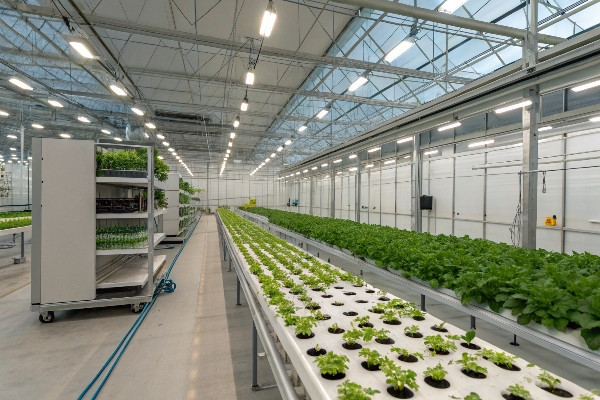
There’s sometimes a perception gap when it comes to manufacturing quality from different regions. However, based on our 28+ years at CFGET, headquartered in Chengdu, China, I can confidently say that you absolutely can source top-tier hydroponic greenhouses and systems from China. The key is partnering with the right manufacturer – one with proven experience, a focus on quality control, and an understanding of international standards and diverse client needs.
At CFGET, we’ve built our reputation on providing exactly that. We manage the entire process from design and manufacturing to technical support and after-sales service. This integrated approach allows us to maintain strict quality control at every stage. We use high-grade materials selected for durability and performance, whether it’s galvanized steel for structures that need to withstand harsh Central Asian winters or advanced polycarbonate glazing for energy efficiency sought by European clients. Our designs incorporate the latest environmental control technologies2, ensuring precise management of temperature, humidity, light, and irrigation – factors critical for successful hydroponics.
We understand that "quality" isn’t just about the physical product; it’s also about suitability and support. About 70% of commercial hydroponic operations utilize greenhouses because they provide essential environmental control, separating the crop from unpredictable external conditions. We tailor our greenhouse designs to specific regional requirements. For Southeast Asia, this means robust ventilation and cooling systems to handle heat and humidity, often incorporating features for rapid installation. For Europe and America, precision, automation, and sustainability certifications might be the focus. For Central Asia, durability against extreme weather and responsive after-sales support are paramount.
We leverage China’s manufacturing capabilities to offer cost-effective solutions without compromising on quality or technology. Our extensive global experience, with projects in over 20 countries, means we understand the nuances of different markets and growing conditions. We don’t just sell a product; we provide a complete solution, including technical guidance on system operation and even advice on challenges like optimizing nutrient ratios for specific crops – a common hurdle we help growers overcome. Choosing a CFGET greenhouse means investing in a reliable, efficient, and profitable growing environment backed by decades of expertise. We ensure our clients, whether they are agents, large producers, or research institutions, receive systems built for long-term success.
| Feature | CFGET’s Approach | Benefit to Client | Target Audience Relevance |
|---|---|---|---|
| Experience | 28+ years in greenhouse design & manufacturing. | Proven reliability, deep understanding of agricultural needs. | Reassurance for all clients (Agents, Growers, Institutions). |
| Quality Control | Integrated process: R&D, production, after-sales; use of high-grade materials. | Durable, long-lasting structures and systems; consistent performance. | Meets demand for durability (Central Asia) & precision (Europe/America). |
| Customization | Tailored designs for specific climates, crops, and operational needs. | Optimal growing environment, addresses local challenges (e.g., humidity, cold). | High adaptability crucial for SE Asia, Europe/America, Central Asia. |
| Technology | Incorporation of advanced environmental controls, efficient hydroponic systems. | Precision agriculture, resource efficiency (water, energy), high yields. | Meets need for precision (Europe/America), efficiency (all), yield (Growers). |
| Cost-Effectiveness | Leveraging manufacturing advantages while maintaining high standards. | Competitive pricing, excellent value for investment (ROI). | Key requirement for all markets, especially high-value growers & large producers. |
| Global Reach | Projects in 20+ countries; understanding of diverse markets. | Solutions proven in various conditions; relevant experience. | Builds trust with international clients (SE Asia, Europe/America, Central Asia). |
| Support | Technical guidance, after-sales service, expertise in hydroponic challenges (nutrients). | Faster problem-solving, smoother operation, reduced learning curve. | Addresses need for service guarantees, especially valued in Central Asia & by agents. |
| Versatility | Solutions for greenhouses, plant factories, container farms. | Flexible options beyond traditional greenhouses. | Caters to diverse client types including research institutions, specialized growers. |
Conclusion
Successful commercial hydroponics integrates smart design, robust construction, and careful financial planning. Partnering with experienced providers like CFGET ensures quality, suitability, and support for long-term profitability.



